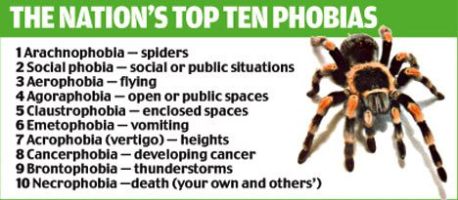Do you avoid taking a ride in elevators or highway roads?? Are you scared to go in public?? If you are suffering from any irrational fear because of an object or situation then you are probably suffering from phobia. Phobia is a kind of anxiety disorder in which the sufferer dreads of a situation, living creature, place or a thing. For some people even thinking of their phobia is immensely distressing.
A phobia develops when a person continuously avoids facing their object of fear. It is more serious than a simple fear. There are many kinds of phobias. But some phobias make an individual’s life difficult like agoraphobia (scared of public and going in social) and few phobias which don’t affect a individuals life like phobia of snakes. This phobia won’t do any harm to their daily life.
Sometimes the word phobia is mistaken as discrimination or prejudice rather than fear. Like homophobia, it is not an uncontrollable fear of homosexuals but a discrimination against them. Many old age people don’t like teenagers and youth which are called as ephebiphobia.
NORMAL FEAR AND PHOBIA?? IS IT ANY DIFFERENT??
It is a very natural to experience fear in dangerous dark situations. Fear is a human adaptive response activating the automatic flight or fight response.
But with the phobias the whole thing is very much exaggerated. Like it is very normal to be afraid of a snarling Doberman but it is irrational to be afraid of a friendly cute poodle if you experiencing a dog phobia.
HOW COMMON ARE PHOBIAS???
In Industrial nations, phobias are the most common anxiety disorder. Over 50 million people in the US and 10 million people in the UK are thought to live with a phobia. They can affect people of any age, sex and socio economic status.
A much higher percentages of females suffer from phobia compared to males
Simple phobias generally start in early childhood and fade away by teens. Complex phobias generally start later on.
CAUSE OF PHOBIA:
Simple phobia usually develops in early childhood like 4 and 8 years of age. In few cases it might be due to an experience early in life. The trigger must be an unpleasant fearful experience which over the time developed into claustrophobia.
If one of the parents is phobic about any object then his kid is more likely to be phobic because they are learned fears from parents and it is not genetically inherited.
COMMON TYPES OF PHOBIAS: Simple and Complex phobia
These are the types of simple phobias:
- Animal phobias: this includes fear of snakes (opidiophobia), fear of dogs (cynophobia), and fear of birds (ornithophobia).
- Natural environment phobias: this includes fear of heights, fear of water, fear of dark and fear of storms
- Situational phobias (triggered by a specific situation): this includes fear of flying, fear of enclosed spaces (claustrophobia), fear of tunnels, fear of driving
- Blood Injection Injury phobia: This includes fear of blood, fear of injection, and fear of an injury.
Complex phobias:
These affect patients in a much more severe way compared to the simple phobias. Those who suffer from for example agoraphobia may have many other associated phobias as well like monophobia (fear of being left alone) or claustrophobia (fear of being trapped).
SOCIAL PHOBIA AND FEAR OF PUBLIC SPEAKING:
Social phobia also called as social anxiety disorder is a fear of social situations. This makes a person very self conscious of themselves and it is experienced by people who are afraid of humiliating themselves in front of others. Anxiety can be of how you look, how you present and how you talk with others.
This kind of phobia makes it difficult for the person to talk or present themselves in a huge crowd. Other fears associated with social phobia are taking exams, mingling with strangers, drinking in public and to be called on in class.
AGORAPHOBIA (fear of open spaces):
Basically it is a fear of an open space but now it is understood as a complication of panic attacks. These people try to avoid crowded places like shopping malls, conferences, gathering which makes a difficult escape.
SIGNS AND SYMPTOMS OF PHOBIA:
Typically the more you run away from fear, the more fearful you will tend to be. Your fear will also be higher if getting away is difficult.
Physical signs and symptoms of Phobia:
– Difficulty breathing (breathlessness)
– Pounding heart (palpitations)
– Chest pain or tightness (angina)
– Trembling or shaking
– Feeling dizzy
– Sweating
– Hot or cold flashes
Emotional signs and symptoms of Phobia:
– Feeling of anxiety
– Fear of losing control or going crazy
– Feeling like you are going to die
– Feeling an intense need of help
WHEN TO CONSIDER TREATMENT??
– It causes intense and disabling fear, anxiety and panic
– You recognize that your fear is unreasonable and excessive
– You avoid many situations and places because of phobia
– You have had the phobia for more than 6 months
– Your avoidance might cause significant distress in your daily life.
TIPS FOR PHOBIA TREATMENT:
TIP 1: Face your fears, one step at a time
TIP 2: Learn relaxation techniques like simple deep breathing exercises
TIP 3: Challenge negative thoughts

